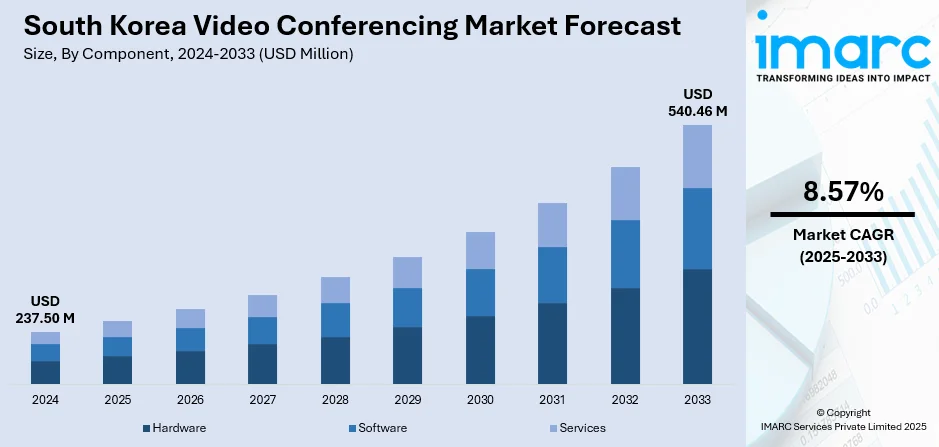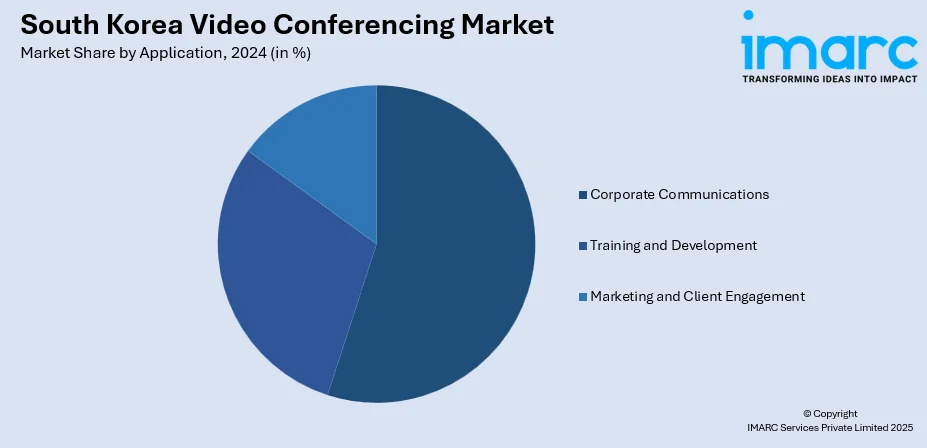
South Korea Video Conferencing Market Size, Share, Trends and Forecast by Component, Conference Type, Deployment Mode, Enterprise Size, Application, End Use, and Region, 2025-2033
South Korea Video Conferencing Market Overview:
The South Korea video conferencing market size reached USD 237.50 Million in 2024. The market is projected to reach USD 540.46 Million by 2033, exhibiting a growth rate (CAGR) of 8.57% during 2025-2033. At present, businesses are using video tools to maintain communication, boost productivity, and reduce travel costs, while schools and universities rely on them for virtual classes, discussions, and training. Besides this, the growing adoption of remote work arrangements is contributing to the expansion of the South Korea video conferencing market share.
|
Report Attribute
|
Key Statistics
|
|---|---|
|
Base Year
|
2024
|
|
Forecast Years
|
2025-2033
|
|
Historical Years
|
2019-2024
|
| Market Size in 2024 | USD 237.50 Million |
| Market Forecast in 2033 | USD 540.46 Million |
| Market Growth Rate 2025-2033 | 8.57% |
South Korea Video Conferencing Market Trends:
Rising adoption of online education
Increasing adoption of online education is fueling the market growth in South Korea. As more schools, universities, and private institutions are shifting towards digital learning, the need for reliable and interactive video platforms is rising. Students attend virtual classes, participate in group discussions, and complete assignments through video conferencing tools. These platforms make learning more flexible, allowing students to join from anywhere, which is especially helpful for those in remote areas. Teachers also benefit by being able to manage large groups, share digital content, and record sessions for later use. Online education is not limited only to formal schooling, as language courses, test prep, and skill-based training programs are also moving online. Parents prefer platforms that offer live interaction and real-time feedback, which video conferencing enables. The convenience of attending classes without commuting and the ability to replay lessons make video learning more appealing. As competition among educational institutions is growing, they are investing in high-quality video solutions to improve their offerings. In South Korea’s tech-savvy environment, students and educators are adapting quickly to these tools. This transition to electronic learning (e-learning) continues to catalyze the demand for stable, user-friendly video conferencing platforms that support long-term virtual education. As per the IMARC Group, the South Korea e-learning market is set to attain USD 11,529.0 Million by 2033, exhibiting a growth rate (CAGR) of 6.53% during 2025-2033.

To get more information on this market, Request Sample
Growing remote work culture
Rising remote work culture is propelling the South Korea video conferencing market growth. As per industry reports, the prevalence of remote work increased from 45% in Q3 2024 to 48% in Q4 2024. As more companies are adopting flexible work arrangements, the need for tools that support virtual communication and collaboration is rising. Video conferencing allows employees to attend meetings, share updates, and work on projects together without being in the same physical space. It helps maintain team productivity, improves communication, and supports real-time decision-making. Many businesses find it cost-effective, as it reduces travel and office expenses. Startups, tech firms, and traditional companies rely on video calls for daily operations, client interactions, and internal discussions. Managers are employing it to track progress, while teams stay connected regardless of location. The ability to integrate video platforms with other tools like calendars, file sharing, and messaging apps also adds convenience. In South Korea, where digital infrastructure is strong, remote work is more easily supported, further boosting video conferencing adoption. This cultural and workplace shift is making video communication not just a temporary solution but a long-term business necessity.
South Korea Video Conferencing Market Segmentation:
IMARC Group provides an analysis of the key trends in each segment of the market, along with forecasts at the country and regional levels for 2025-2033. Our report has categorized the market based on component, conference type, deployment mode, enterprise size, application, and end use.
Component Insights:
- Hardware
- Camera
- Microphone/Headphone
- Others
- Software
- Services
- Professional Services
- Managed Services
The report has provided a detailed breakup and analysis of the market based on the component. This includes hardware (camera, microphone/headphone, and others), software, and services (professional services and managed services).
Conference Type Insights:
- Telepresence System
- Integrated System
- Desktop System
- Service-based System
A detailed breakup and analysis of the market based on the conference type have also been provided in the report. This includes telepresence system, integrated system, desktop system, and service-based system.
Deployment Mode Insights:
- On-premises
- Cloud-based
The report has provided a detailed breakup and analysis of the market based on the deployment mode. This includes on-premises and cloud-based.
Enterprise Size Insights:
- Large Enterprises
- Small and Medium-sized Enterprises
A detailed breakup and analysis of the market based on the enterprise size have also been provided in the report. This includes large enterprises and small and medium-sized enterprises.
Application Insights:

- Corporate Communications
- Training and Development
- Marketing and Client Engagement
The report has provided a detailed breakup and analysis of the market based on the application. This includes corporate communications, training and development, and marketing and client engagement.
End Use Insights:
- Corporate
- Education
- Healthcare
- Government and Defense
- BFSI
- Media and Entertainment
- Others
A detailed breakup and analysis of the market based on the end use have also been provided in the report. This includes corporate, education, healthcare, government and defense, BFSI, media and entertainment, and others.
Regional Insights:
- Seoul Capital Area
- Yeongnam (Southeastern Region)
- Honam (Southwestern Region)
- Hoseo (Central Region)
- Others
The report has also provided a comprehensive analysis of all the major regional markets, which include Seoul Capital Area, Yeongnam (Southeastern Region), Honam (Southwestern Region), Hoseo (Central Region), and others.
Competitive Landscape:
The market research report has also provided a comprehensive analysis of the competitive landscape. Competitive analysis such as market structure, key player positioning, top winning strategies, competitive dashboard, and company evaluation quadrant has been covered in the report. Also, detailed profiles of all major companies have been provided.
South Korea Video Conferencing Market News:
- In July 2025, Tencent Cloud declared its dedication to assisting more web-based companies in South Korea to expand and innovate, utilizing artificial intelligence (AI) and media technologies that would bring about more interactive, immersive, and engaging user experiences. Leveraging significant expertise in AI innovation and implementation, Tencent Cloud delivered value through offerings such as video conferencing, advertising, collaboration tools, and cloud computing.
- In April 2024, DTEN, a top provider of video conferencing solutions, declared that its premier product, the DTEN D7X series, was live for sale in South Korea. Offered in 55” and 75” screen sizes, the D7X All-in-One solution featured a 4K camera, an impressive 15 Microphone array for immersive sound, and advanced touch technology, ensuring seamless writing experiences and easy collaboration with whiteboard applications.
South Korea Video Conferencing Market Report Coverage:
| Report Features | Details |
|---|---|
| Base Year of the Analysis | 2024 |
| Historical Period | 2019-2024 |
| Forecast Period | 2025-2033 |
| Units | Million USD |
| Scope of the Report |
Exploration of Historical Trends and Market Outlook, Industry Catalysts and Challenges, Segment-Wise Historical and Future Market Assessment:
|
| Components Covered |
|
| Conference Types Covered | Telepresence System, Integrated System, Desktop System, Service-based System |
| Deployment Modes Covered | On-premises, Cloud-based |
| Enterprise Sizes Covered | Large Enterprises, Small and Medium-sized Enterprises |
| Applications Covered | Corporate Communications, Training and Development, Marketing and Client Engagement |
| End Uses Covered | Corporate, Education, Healthcare, Government and Defense, BFSI, Media and Entertainment, Others |
| Regions Covered | Seoul Capital Area, Yeongnam (Southeastern Region), Honam (Southwestern Region), Hoseo (Central Region), Others |
| Customization Scope | 10% Free Customization |
| Post-Sale Analyst Support | 10-12 Weeks |
| Delivery Format | PDF and Excel through Email (We can also provide the editable version of the report in PPT/Word format on special request) |
Key Questions Answered in This Report:
- How has the South Korea video conferencing market performed so far and how will it perform in the coming years?
- What is the breakup of the South Korea video conferencing market on the basis of component?
- What is the breakup of the South Korea video conferencing market on the basis of conference type?
- What is the breakup of the South Korea video conferencing market on the basis of deployment mode?
- What is the breakup of the South Korea video conferencing market on the basis of enterprise size?
- What is the breakup of the South Korea video conferencing market on the basis of application?
- What is the breakup of the South Korea video conferencing market on the basis of end use?
- What is the breakup of the South Korea video conferencing market on the basis of region?
- What are the various stages in the value chain of the South Korea video conferencing market?
- What are the key driving factors and challenges in the South Korea video conferencing market?
- What is the structure of the South Korea video conferencing market and who are the key players?
- What is the degree of competition in the South Korea video conferencing market?
Key Benefits for Stakeholders:
- IMARC’s industry report offers a comprehensive quantitative analysis of various market segments, historical and current market trends, market forecasts, and dynamics of the South Korea video conferencing market from 2019-2033.
- The research report provides the latest information on the market drivers, challenges, and opportunities in the South Korea video conferencing market.
- Porter's five forces analysis assist stakeholders in assessing the impact of new entrants, competitive rivalry, supplier power, buyer power, and the threat of substitution. It helps stakeholders to analyze the level of competition within the South Korea video conferencing industry and its attractiveness.
- Competitive landscape allows stakeholders to understand their competitive environment and provides an insight into the current positions of key players in the market.
Need more help?
- Speak to our experienced analysts for insights on the current market scenarios.
- Include additional segments and countries to customize the report as per your requirement.
- Gain an unparalleled competitive advantage in your domain by understanding how to utilize the report and positively impacting your operations and revenue.
- For further assistance, please connect with our analysts.
 Request Customization
Request Customization
 Speak to an Analyst
Speak to an Analyst
 Request Brochure
Request Brochure
 Inquire Before Buying
Inquire Before Buying




.webp)




.webp)












